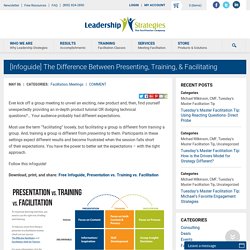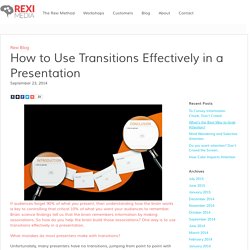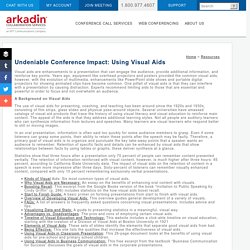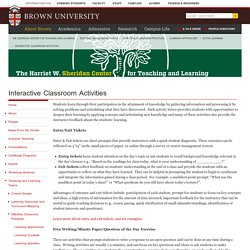Zoom
Trash
Related: Visual aids and templates
- Games
- Engelska F-6
- GAMES
- El Mejor Maestro
- Be an outstanding educator
- Gamification
- Meeting
- Education
- Enterprise

Leadership Strategies » Blog Archive Leadership Strategies. Ever kick off a group meeting to unveil an exciting, new product and, then, find yourself unexpectedly providing an in-depth product tutorial OR dodging technical questions?

… Your audience probably had different expectations. Most use the term “facilitating” loosely, but facilitating a group is different from training a group. And, training a group is different from presenting to them. Participants in these settings expect different results and become frustrated when the session falls short of their expectations.
You have the power to better set the expectations – with the right approach. Follow this infoguide! Download, print, and share: Free Infoguide, Presentation vs. Using Transition Phrases to Keep Your Audience Engrossed in Your Presentation - Presenting Yourself and more . . .Presenting Yourself and more . . . By Joyce Newman, The Newman Group, Inc. — You’ve worked hard at creating your presentation with compelling key messages and images.

Let’s face it, though. Even the most interested listener will wander off mentally at least once during your presentation. Many won’t be able to resist the temptation to take a peek at their smart phones. How to Use Transitions Effectively in a Presentation - Rexi Media. If audiences forget 90% of what you present, then understanding how the brain works is key to controlling that critical 10% of what you want your audiences to remember.

Brain science findings tell us that the brain remembers information by making associations. So how do you help the brain build those associations? One way is to use transitions effectively in a presentation. What mistakes do most presenters make with transitions? Unfortunately, many presenters have no transitions, jumping from point to point with no apparent logic; others transition too quickly, or transition in the same way, which becomes dull. 3 Make Sure It Is Cohesive. In the perfect symphony, the composer must make sure that every note that should be in the symphony is included and that every note that should not be included is excluded, as the following quotation from Leonard Bernstein so artfully points out.

We are going to try to perform for you today a curious and rather difficult experiment. We're going to take the first movement of Beethoven's Fifth Symphony and rewrite it. Now don't get scared; we're going to use only notes that Beethoven himself wrote. We're going to take certain discarded sketches that Beethoven wrote, intending to use them in this symphony, and find out why he rejected them, by putting them back into the symphony and seeing how the symphony would have sounded with them. Just as the perfect symphony has included all of the notes that should be included and has not included any notes that should in fact be excluded, Master_Presenters do the same with their words. Step 1: Write a Mission Statement Step 5: Test the Presentation. Undeniable Conference Impact: Using Visual Aids. Visual aids are enhancements to a presentation that can engage the audience, provide additional information, and reinforce key points.

Years ago, equipment like overhead projectors and posters provided the common visual aids; however, with the evolution of multimedia, enhancements like PowerPoint slide shows and portable digital projectors for showing animated clips have become common. One pitfall of visual aids is that they can interfere with a presentation by causing distraction.
Experts recommend limiting aids to those that are essential and powerful in order to focus and not overwhelm an audience. A Background on Visual Aids The use of visual aids for presenting, coaching, and teaching has been around since the 1920s and 1930s, consisting of film strips, glass slides and physical pass-around objects. Log In to Mind Tools. Working with Visual Aids - Presentation Skills. 101 Tips. The Sheridan Center for Teaching and Learning. Students learn through their participation in the attainment of knowledge by gathering information and processing it by solving problems and articulating what they have discovered.

Each activity below provides students with opportunities to deepen their learning by applying concepts and articulating new knowledge and many of these activities also provide the instructor feedback about the students’ learning. Entry/Exit Tickets Entry & Exit tickets are short prompts that provide instructors with a quick student diagnostic. These exercises can be collected on 3”x5” cards, small pieces of paper, or online through a survey or course management system. Entry tickets focus student attention on the day’s topic or ask students to recall background knowledge relevant to the day’s lesson: e.g., “Based on the readings for class today, what is your understanding of ___________?”
Learn more about entry and exit tickets, and see examples. Free Writing/Minute Paper/Question of the Day Exercise. Asking questions of your audience. Asking questions of your audience is a great way to keep the audience engaged.

But asking questions is an art. I asked on Twitter what people found hardest about asking questions that engage your audience: Lee Potts from Breaking Murphy’s Law “Posing the question in such a way that guarantees someone, anyone, will answer and not leave me hanging.” Brent Dykes from PowerPoint Ninja “How to recover from a question or series of questions that get crickets (i.e., silence)?” You ask a question and the audience looks blankly back at you You may have suffered the same fate.
Here are the 10 steps for asking questions in a presentation which will help you avoid being left hanging.